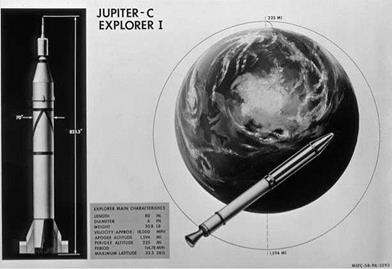The Sergeant Missile Powerplant
Meanwhile, the first major application of the technologies developed for the RV-A-10 was the Sergeant missile, for which JPL began planning in 1953 under its ORDCIT contract with Army Ordnance. JPL submitted a proposal for a Sergeant missile in April 1954, and on June 11, 1954, the army’s chief of ordnance programmed $100,000 for it. At the same time, he transferred control of the effort to the commanding general of Redstone Arsenal. Using lessons learned from the liquid-propellant Corporal missile, JPL proposed a co-contractor for the development and ultimate manufacture of the missile. In February 1956, a Sergeant Contractor Selection Committee unanimously chose Sperry Gyroscope Company for this role, based on JPL’s recommendation and Sperry’s capabilities and experience with other missiles, including the Sparrow I air-to-air missile system for the navy. In April 1954, the Redstone Arsenal had reached an agreement with the Redstone Division of Thiokol to work on the solid-propellant motor for the Sergeant, with the overall program to develop Sergeant beginning in 1955.30
There is no need to provide a detailed history of the Sergeant missile here. It took longer to develop than originally planned and was not operational until 1962. By then the navy had completed the far more significant Polaris A1, and the air force was close to fielding the much more important Minuteman I. The Sergeant did meet a slipped ordnance support readiness date of June 1962 and became a limited-production weapons system until June 1968. It did equal its predecessor, Corporal, in range and firepower in a package only
FIG. 6.3
 Technical drawing of the Jupiter C (actually,
Technical drawing of the Jupiter C (actually,
Juno I, including scaled-down Sergeant upper stages) with America’s first satellite, Explorer I, showing the latter’s characteristics. (Photo courtesy of NASA)
![]()
half as large and requiring less than a third as much ground-support equipment. Its solid-propellant motor could also be readied for firing much more quickly than the liquid-propellant Corporal.31
The Sergeant motor was a modification or direct descendant of the RV-A-10’s motor. The latter (using the TRX-110A propulsion formulation) employed 63 percent ammonium perchlorate as an oxidizer, whereas the TP-E8057 propellant for the Sergeant motor (designated JPL 500) had 63.3 percent of that oxidizer and 33.2 percent LP-33 liquid polymer in addition to small percentages of a curing agent, two reinforcing agents, and a curing accelerator. At a nozzle expansion ratio of 5.39, its specific impulse was about 185 lbf-sec/lbm, considerably lower than the performance of Polaris A1. It employed a five-point-star grain configuration, used a case of 4130 steel at a nominal thickness of 0.109 inch (almost half that of the RV-A-10 case), and a nozzle (like that of the RV-A-10) using 1020 steel with a graphite nozzle-throat insert.32 Ironically, perhaps, the main contributions the Sergeant made to launch-vehicle technology were through a scaled-down version of the missile used for testing. These smaller versions became the basis for upper stages in reentry test vehicles for the Jupiter missile and in the launch vehicles for Explorer and Pioneer satellites.33










